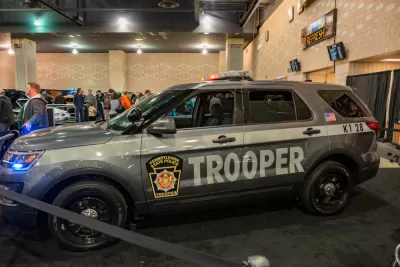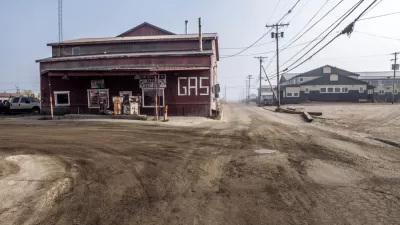The state with the highest fuel taxes has the second most structurally deficient bridges. According to the Pennsylvania state auditor's new report, diversion of $4.2 billion to fund the state police during the last six years is to blame.

Generally speaking, general funds and non-transportation taxes are often diverted to fund road building, particularly in states that haven't been increasing fuel taxes. Pennsylvania may be the exception.
"Auditor General Eugene DePasquale unveiled an audit of PennDOT [on April 25] that found the agency, at the direction of the state Legislature, has had to divert $4.25 billion from the motor license fund to state police over the last six years even though, under the state constitution, proceeds are supposed to be used for the construction, maintenance and repair of highways and bridges," reports J.D. Prose for the Beaver County Times.
“More than 2,800 state-maintained bridges across Pennsylvania are structurally deficient, and our bridges average over 50 years in age beyond what they were designed to last,” DePasquale said in a statement. “That $4.25 billion could have cut that list in half, and if PennDOT could use all of the gas tax money for roads and bridges, we could get that number to zero in about five years.”
"A recent report by the American Road and Transportation Builders Association ranked Pennsylvania second among the states for the second year in a row for its number of structurally deficient bridges," trailing only Iowa, adds Prose.
While the Pennsylvania State Police patrol Pennsylvania's highways, they also perform many other statewide law enforcement functions, and more recently have been functioning "as the primary police presence in much of rural Pennsylvania," reports John Finnerty for The Daily Item.
Last year alone, seven local police departments disbanded, leaving the communities relying on state police for protection, state police Lt. Col. Robert Evanchick said in a budget hearing this spring.
Gov. Tom Wolf has proposed a per-capita fee, based on population size on communities without local police departments, to generate additional funding for state police as the state seeks to decrease the amount coming out of the gas tax fund.
Fuel tax revenues comprised 77 percent of the $4.5 million Motor License Fund from 2016-2017, with licenses and fees at 22 percent, according to the Pennsylvania Department of Transportation's (PennDOT) 2017 Annual Report [pdf]. The second largest expenditure that year, after highway maintenance, was for State Police - $792,883.
The controversy over the use of gas tax funding to pay for state police has been festering for years... Those concerns were amplified by Act 89, the 2013 law that gave Pennsylvania the highest gas tax in the country, said Jason Wagner, director of government affairs for the Associated Pennsylvania Constructors, a trade group representing road-building contractors.
Pennsylvania's gas tax was 58.7 cents per gallon on April 1, according to API. California had the second highest, at 55.18 CPG.
A 2017 study by the state’s Legislative Budget and Finance Committee explored the issue by trying to quantify how much of state police time could be considered patrol activity. They concluded that the state was diverting $220 million a year to state police than appropriate [sic].
However, traffic enforcement and public safety is not pavement maintenance, so even those legitimate highway duties would appear to be outside of the functions of the Motor License Fund.
Appearing with Auditor General DePasquale at the press conference by a 91-year-old bridge in Harrisburg was PennDOT Secretary Leslie Richards, noted J.D. Prose.
“With the release of this report, there’s even more evidence of the urgent need for sustainable transportation funding in Pennsylvania and the importance of investing in our transportation network,” she said. That is certainly the case with states that haven't increased their gas taxes, but in the Keystone State, the real challenge may be finding funding for the state police, and its growing role in local law enforcement, to replace the revenue from the Motor License Fund.
The Pennsylvania Highway Information Association, a “highway users” organization, has a webpage devoted to Motor License Fund Diversion.
Related in Planetizen:
- Effort Underway to Halt Pennsylvania's Gas Tax Increase, July 26, 2016
- Pennsylvania Launches 'Rapid Bridge Project' to Rebuild 558 Bridges in Three Years, November 15, 2015
- SEPTA Plans How to Spend Gas Tax Windfall, December 20, 2013
- Transit, Biking and Walking are Big Winners in Pennsylvania Gas Tax Increase, November 29, 2013
- Pennsylvania Gas Tax Hike Clears House, November 21, 2013
FULL STORY: DePasquale: $4 billion shifted from PennDOT to state police since 2012 could fix roads, bridges

Alabama: Trump Terminates Settlements for Black Communities Harmed By Raw Sewage
Trump deemed the landmark civil rights agreement “illegal DEI and environmental justice policy.”

Planetizen Federal Action Tracker
A weekly monitor of how Trump’s orders and actions are impacting planners and planning in America.

Why Should We Subsidize Public Transportation?
Many public transit agencies face financial stress due to rising costs, declining fare revenue, and declining subsidies. Transit advocates must provide a strong business case for increasing public transit funding.

Understanding Road Diets
An explainer from Momentum highlights the advantages of reducing vehicle lanes in favor of more bike, transit, and pedestrian infrastructure.

New California Law Regulates Warehouse Pollution
A new law tightens building and emissions regulations for large distribution warehouses to mitigate air pollution and traffic in surrounding communities.

Phoenix Announces Opening Date for Light Rail Extension
The South Central extension will connect South Phoenix to downtown and other major hubs starting on June 7.
Urban Design for Planners 1: Software Tools
This six-course series explores essential urban design concepts using open source software and equips planners with the tools they need to participate fully in the urban design process.
Planning for Universal Design
Learn the tools for implementing Universal Design in planning regulations.
Caltrans
Smith Gee Studio
Institute for Housing and Urban Development Studies (IHS)
City of Grandview
Harvard GSD Executive Education
Toledo-Lucas County Plan Commissions
Salt Lake City
NYU Wagner Graduate School of Public Service





























